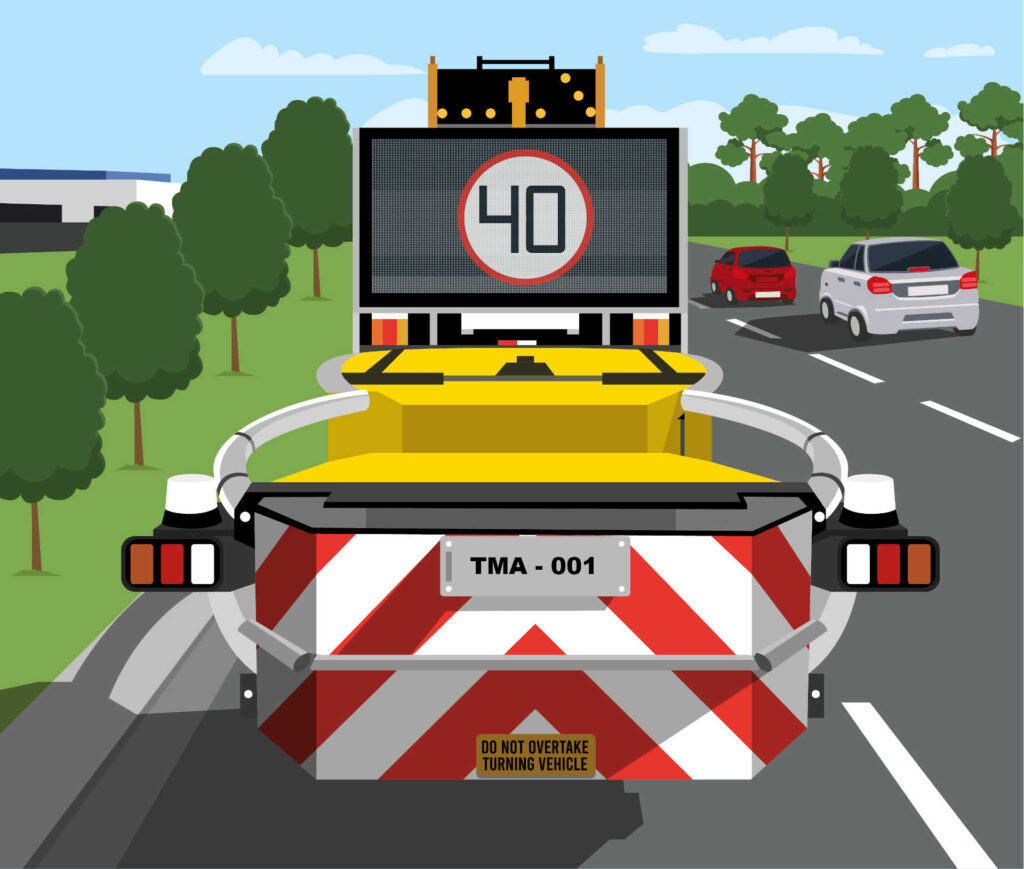A truck-mounted attenuator (TMA) can be the difference between life and death at a roadside construction site or worksite. Intended to absorb the impact of a crash, TMAs are designed to decrease vehicle damage, and save lives. TMAs are compulsory within many Australian roadside worksites – read on to find out what they are, and when they are needed.
What Is an Impact Attenuator, How Do They Work and What Is Their Primary Purpose?
TMAs are required to improve the safety of workers on or adjacent to all high-speed roads by providing physical protection when road closure or temporary safety barriers are impractical. Connecting to the back of work vehicles at risk of being struck from behind, a TMA aims to absorb energy from a colliding vehicle, reducing the impact on both vehicles and lowering the risk of injury to any occupants or nearby workers.
When is a TMA Required?
The requirement of a TMA is generally determined by a hazard assessment. In most instances a TMA is mandatory when doing works on or near a freeway (M class roads, such as M1) and other high-speed roads of speed 80 km/h and higher.
When completing a hazard assessment for traffic management implementation, the requirement is to implement the highest levels of control measures first. These are Elimination measures – road closure and detour are the highest levels of safety controls. If these can’t be achieved then Isolation and Engineering measures are required – safety barriers, lane closure adjacent to work area and vehicle-mounted attenuators. The lowest form of safety controls are Administrative measures – speed reduction, warning signs, delineation of travelled path, traffic controllers. The reason why they are the lowest form of safety measures is because they rely on the behaviour of the road user and their willingness to observe the advance warning signs and abide by the speed signs.
If a TMA is not suitable for a particular job or at a certain location, the reason must be documented and explained in a hazard assessment.
For example, some rural roads are un-signed, and the default speed limit is 100 km/h, however, the road may be winding and narrow, which would mean the use of a TMA is not practical and in some cases could actually be an additional hazard. Conversely, there are instances where works may be occurring on roads with lower speed limits such as 70 km/h where the workers and the work area could benefit by having a TMA on site protecting them.
When to Use a TMA
According to VicRoads guidelines, when determining if a TMA should be utilized, the criteria below should be considered. If the works meet 1 & 2 first, then a TMA must be incorporated into the traffic management arrangements.
- Substantive speed limit ≥ 80 km/h (Note: Lower worksite speed limits should be posted for longer term deployment particularly for night works).
- Highest control practicable under the hierarchy of safety controls for worksite traffic management. Road closure or temporary safety barriers are not practicable due to the short duration mobile nature of the works.
- Work is adjacent to or on traffic lane(s) and includes erecting signing where applicable. A TMA is also mandatory for all progressively moving work utilising a trafficked lane.
- Work is not protected by safety barriers or works are within the clear zone at the posted speed limit for the adjacent traffic (Refer Worksite Safety – Traffic Management Code of Practice 2010).
- Work is required within the ‘No Go Zone’ behind temporary safety barriers. *
TMAs for Emergency Works
TMAs are often deployed for short-duration, emergency road repairs. In non-emergency sites, advance warning signing and delineation is also required. However, in emergencies this isn’t needed immediately, providing vehicles have at least a 200-metre approach sight distance of the worksite. Advance signing and bollard delineation must be deployed as soon as practicable, unless the worksite is located completely off road, in verge or in an emergency lane.
TMAs Save Lives
They save the lives of workers on or near roads, the traffic controllers implementing traffic management devices and the lives of the motorists. Mistakes on the road are often beyond control, this can lead to death or serious injury. TMAs accommodate for human error by protecting road workers and preventing road trauma by reducing crash forces to survivable limits.
Speak to Us About TMAs
Our tailored traffic management plans ensure your staff, pedestrians and motorists are safe in work zones that feature roadside construction. Many traffic plans include the use of TMAs; as the gold standard in traffic management plans, we are here to help with expert advice and professional traffic management plan that falls in line with all the necessary industry codes and regulations. Enquire online now or call our friendly team today on 03 9066 4417.
References
*VicRoads – Guidelines for the use of Truck Mounted Attenuators – (TMA) – July 2014
The Traffic Plans Company specialise in quality traffic management plans and planning around Melbourne and other areas of Australia.

